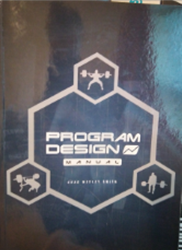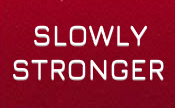Book Score
5/10 – Not recommended!
Introduction

This is a review of Chad Wesley Smith’s (Juggernaut Training Systems) book Powerlifting Program Design Manual. At the time of writing, it is available as an eBook for $37 or paperback for $42 from the Juggernaut Training Systems website. I will be reviewing the paperback version.
The book immediately sets out what it aims to achieve: “The objective of this book is to bridge the gap between Scientific Principles of Strength Training and giving you pre-written programs or templates, we want to equip you to create programs for yourself and your athletes for a life-time of training.”
Content of the Book
The good
The Powerlifting Program Design Manual set out its objective as aiming to equip the reader with the skills to write their own program. It does, in the most part, achieve this objective.
Most companies that sell strength-training products usually have their own ‘style’ of programming. This book focuses on writing programs in blocks with varying amounts of volume and intensity. This is the only style of programming the book covers. This isn’t necessarily a bad thing, but it is worth being aware that this is what you will be getting.
The book offers a logical system around how to assess athletes, and then how to use this assessment to write a program around the athlete, and if you follow its system you can definitely write a decent program. Using myself as a test-subject, I was able to create a program for myself that looked like it would work just as well as the examples offered by the book, and I would feel confident in writing programs using this system for the future. So it did, without a doubt, achieve its objective in equipping the lifter with the skills to rite their own program.
There also isn’t anything too complicated in the book. Some areas could be better explained (see “The bad” below), but overall, you wouldn’t have to re-read the book several times to understand the necessary information to create your own programs, especially if you take the authors advice as you go along.
The order of the book is very logical, and helps makes writing programs far more straight forward. It starts off with a chapter on assessing the athlete and offers some background information around the different phases of training (hypertrophy, strength and peaking). The book then looks at using the athlete assessment to determine how much volume they would have per exercise (e.g. how many sets they would do for the squat, bench and deadlift), describes how to split up the sets throughout the training week, and how to determine the exercises throughout the week. It then finally offers a short chapter titled “putting it all together” where everything is recapped succinctly and creates an example program, before then offering a series of sample programs used to fit different athlete assessments.
These final two chapters which bring everything together and followed by the example programs are the highlight of the book. They clearly show how you use all the information discussed in the book before to create a program and really help tie everything in.
Summary:
- The book does equip the reader with the skills to write a powerlifting program.
- The book offers an easy to understand and use system to create individualised programs for people.
- The book is ordered in a very logical manner, aiding the understanding of writing a program.
- The final two chapters bring everything together and really help solidify the readers understanding on how to write programs.
The Bad
I am actually quite fond of the book, which makes the negative elements more disheartening as they had such a negative impact on the reading experience, making me feel like I did not get value for money.
Whilst the paperback version of the book certainly looks good, the actual content is unfinished and ripe with errors. This book would never be published by any reputable publisher, and for good reason. There are a huge number of errors within the book.
There are some sentences that are incomplete. For example, one sentence states “Second, if a deload is” and that’s it, the sentence just ends there without finishing. There are spelling mistakes scattered throughout the book. One page is repeated twice. There are charts at the start of the book to classify what class of lifter you are, yet they are hard to read, require guesswork since the chart just provide numbers with no indication of what the numbers are, and one chart is just repeated.
There are also other issues with the book which make it hard to use. The author offers a “chart” you can use to figure out how to customise programs to an athlete. This chart will look at things like athlete height, weight, training experience, historical workload, age, diet, etc. and you’ll use this chart a few times to determine how much volume to use for each lift, and how frequently to perform each lift. Sounds good right? Sadly, whilst this is a great concept, it has an awful execution. The book starts off describing each of the different characteristics that make up this chart, and the descriptions are good. However, it then compiles these descriptors into a chart but the chart is devoid of any headings – all you have to go off is a row that states “Good, Avg, Poor” or “1, 2, 3, 4, 5”. There is no indication of what you are categorising as good, average or poor; or scoring on a scale of 1-5. Its solely guesswork which row relates to which descriptor. To make it worse, this chart is a key part of the program design, and a key theme throughout the book.
The grammar of the book is poor. Very poor. Many sentences do not make sense. Some sentences have words missing, some have repeated words, some are worded incorrectly, whilst some sentences last an entire paragraph covering numerous points making it hard to follow. All of this makes the book far harder to understand and read, simply because the reader must try and ‘fix’ each sentence to understand what the author is trying to say.
The overall writing style throughout the book is terrible. Some sections are extraordinarily wordy – taking at times numerous pages to describe something that should take a couple of sentences to describe. This would appear to be a minor drawback of the book, but after going through an entire book that is written like this, it is, in my opinion, the biggest drawback of the book. Cutting the word count by at least 25% would offer serious improvements.
The book is advertised as “checking in at over 200 information packed pages”, when in reality there are a huge number of pictures in the book. Some of these pictures serve a purpose (e.g. illustrating an exercise), however many of them serve no purpose and I can only assume they are there to pad the book out and make it appear bigger than it actually is. To put this in perspective, I counted over 50 pictures which I felt served no purpose, and most of these take up half a page.
The font-size is large. This isn’t a bad thing, but with 50 half-page pictures, repeated pages, a lot of rambling and the larger font, it did not feel like “over 200 information packed pages”. It felt like half of that!
Finally, the book does include some nice information around transitional phases and bridge phases, and this does seem interesting and potentially useful. However, the author covers them briefly and never talks about them again. It’d have been useful if these were incorporated into the final examples, rather than just being brought up then forgotten about. I don’t think you would feel equipped to program these phases after reading the book.
Therefore, I cannot support this book being marketed and sold as a finished product, let alone for $42. I do not believe the book was proof-read or edited at all. No editor would leave in repeated pages, incomplete sentences, constant rambling, sentences that don’t make sense and unnecessarily difficult to follow charts. At $42, I felt “ripped off”, which is a real shame because the book had such good potential.
The Print Quality of the Book
The book itself is 217 pages long, with each page being A5 size. The printed version of the book does appear to be high quality, although it is printed in black and white. I believe the eBook is in colour, but I do not have a copy of this to confirm.
As discussed before, I also counted exactly 50 pictures that did not appear to serve any purpose in the book, a lot of them took up around half the entire page. The font is legible, but very large, the pessimist in me thinks this is to artificially inflate the size of the book.
The book being in black and white wouldn’t be an issue, but when some of the graphs are colour-coded yet printed in black and white, you can no longer read the graph.
The final verdict of Powerlifting Program Design Manual
I cannot recommend the Powerlifting Program Design Manual. I feel it is a real shame that I am not recommending this book because it does offer a good system for creating programs and it does achieve its objective at teaching the reader how to write powerlifting programs. However, when the cost is $37-42 for a seemingly unfinished book, and when there are other finished books which achieve the same goal for half the price and are actually finished, I cannot recommend you purchase this book. If it was $5-10, I might consider changing my mind – although even then you would be spending money on what should have been a first or second draft.
I sincerely hope that Juggernaut Training Systems do edit the book and release it without all the errors, without the unclear information and without the “rambling on”, as this would easily be a book I would whole-heartedly recommend in this instance. However, given the book had already been on the market for some time when I purchased it, I am not hopeful at all.
